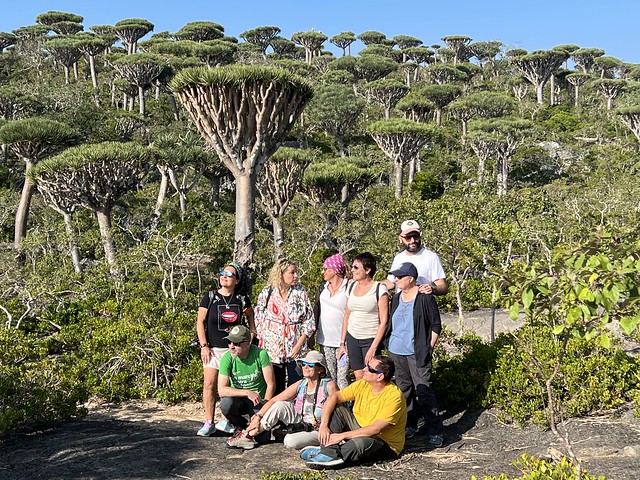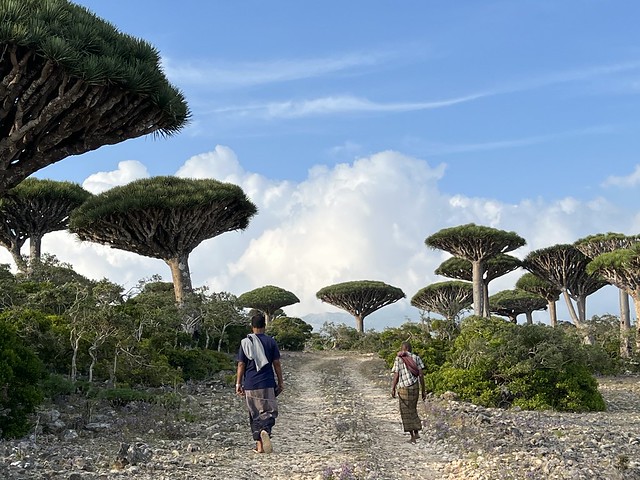Socotra, a remote archipelago in the Arabian Sea, has long been celebrated for its unique biodiversity, otherworldly landscapes, and rich cultural heritage. Often referred to as the “Galápagos of the Indian Ocean,” the island’s isolation has fostered the development of a distinctive ecosystem and culture. However, as tourism begins to take root on Socotra, the impact on its communities and environment is becoming increasingly apparent. This post explores both the challenges and opportunities that tourism presents to Socotra’s communities.
The Allure of Socotra
Socotra’s charm lies in its remarkable natural beauty and unique cultural heritage. The island boasts an array of endemic species, including the bizarre dragon’s blood tree and the rare Socotra cormorant. Its pristine beaches, dramatic cliffs, and ancient baobab trees make it a haven for nature enthusiasts and adventure seekers. The local culture, steeped in traditions and customs that have been preserved for centuries, offers an authentic experience for visitors.
The allure of Socotra has not gone unnoticed by the global travel community. In recent years, there has been a growing interest in this remote destination, leading to an increase in tourist arrivals. For many Socotri people, tourism represents an opportunity to showcase their island and potentially improve their quality of life. However, this influx of visitors brings with it both benefits and challenges.
Challenges Faced by Socotra’s Communities
1. Environmental Impact
One of the most pressing concerns associated with increased tourism is its impact on Socotra’s fragile environment. The island’s ecosystem is highly sensitive, with many species found nowhere else on Earth. The influx of tourists poses a threat to these delicate habitats. Increased foot traffic can lead to soil erosion, disturbance to wildlife, and pollution. Additionally, the rise in waste production and inadequate waste management infrastructure further exacerbates environmental degradation.
2. Cultural Erosion
Socotra’s cultural heritage is deeply intertwined with its natural environment. As tourism grows, there is a risk of cultural erosion, where traditional practices and customs may be overshadowed by the demands of visitors. The commercialization of cultural elements, such as traditional crafts and rituals, can dilute their authenticity and significance. Moreover, the influx of tourists can lead to a loss of traditional knowledge and practices as younger generations may prioritize tourism-related activities over their cultural heritage.
3. Economic Disparities
While tourism has the potential to boost the local economy, it can also exacerbate existing economic disparities. The benefits of tourism may not be evenly distributed among Socotra’s communities. Local businesses and entrepreneurs involved in the tourism industry may see financial gains, while others who do not directly benefit from tourism may face economic challenges. Additionally, the cost of living may increase as demand for goods and services rises, potentially putting a strain on local residents.
4. Infrastructure Strain
Socotra’s infrastructure is not equipped to handle a significant influx of tourists. The island’s roads, accommodation facilities, and transportation systems are limited and may struggle to meet the demands of increased visitor numbers. This strain on infrastructure can lead to overcrowding, reduced quality of services, and potential safety concerns for both tourists and residents.
Opportunities Presented by Tourism
Despite the challenges, tourism also presents several opportunities for Socotra’s communities. When managed responsibly, tourism can contribute to the island’s development and enhance the well-being of its residents.
1. Economic Development
Tourism has the potential to stimulate economic development by creating job opportunities and generating revenue. Local entrepreneurs can benefit from increased business activity, and infrastructure improvements funded by tourism revenue can enhance the quality of life for residents. Additionally, tourism can provide a platform for local artisans and craftspeople to showcase their work, preserving traditional skills and generating income.
2. Cultural Exchange and Preservation
Tourism can foster cultural exchange by allowing Socotri people to share their heritage with visitors from around the world. This interaction can lead to a greater appreciation and understanding of Socotra’s unique traditions and customs. Moreover, the revenue generated from tourism can be reinvested into cultural preservation efforts, supporting initiatives that safeguard traditional practices and sites of historical significance.
3. Environmental Conservation
Tourism can also play a role in environmental conservation. Revenue from park fees, eco-tourism initiatives, and conservation programs can contribute to the protection and preservation of Socotra’s natural landscapes and wildlife. Engaging tourists in conservation efforts, such as guided eco-tours and volunteering opportunities, can raise awareness about the importance of preserving the island’s unique environment.
4. Infrastructure Improvement
The development of infrastructure to accommodate tourism can benefit local communities by improving access to essential services. Upgrades to transportation, healthcare, and communication systems can enhance the overall quality of life for residents. Additionally, improved infrastructure can support other sectors of the economy, such as education and agriculture.

Balancing Tourism and Sustainability
To ensure that tourism benefits Socotra’s communities while minimizing negative impacts, a balanced and sustainable approach is essential. Collaboration between local stakeholders, government authorities, and tourism operators can help develop strategies that address environmental and cultural concerns. Implementing responsible tourism practices, such as limiting visitor numbers, promoting eco-friendly activities, and supporting local businesses, can contribute to the long-term sustainability of tourism on the island.
Education and awareness-raising efforts can also play a crucial role in fostering a culture of responsible tourism among visitors. By promoting an understanding of Socotra’s unique environment and culture, tourists can make more informed choices and contribute to the preservation of the island’s heritage.
Conclusion
The impact of tourism on Socotra people is a complex and multifaceted issue. While tourism presents both challenges and opportunities, a thoughtful and sustainable approach can help ensure that the benefits outweigh the drawbacks. By prioritizing environmental conservation, cultural preservation, and economic development, Socotra can navigate the challenges of tourism while embracing the opportunities it presents. In doing so, the island can continue to share its remarkable beauty and heritage with the world while safeguarding its future for generations to come.

